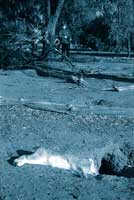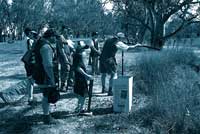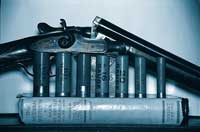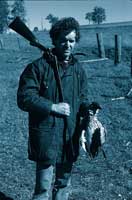The .410 - a diminutive dynamo
by Bruce Moss
Australian Shooter July 2000
Boy’s gun, orchard gun, snake gun. The .410 has been labelled many things and while throughout the years this runt of the shotshell litter has performed these tasks admirably, I personally loathe pigeonholing it, so to speak, to any one of the above categories exclusively.
 While there’s no arguing the .410’s light weight, low-shot volume and close-range effectiveness has kept these labels alive, it has in part also led to the .410 being somewhat looked down on and not quite taken seriously beyond these applications. Ironically, some of the quickest to criticise are shotgunners who, when finally pushed for an answer, reluctantly admit they’ve never used one. Even within the group who grew up with a .410, as I did, there are some that simply couldn’t wait to move up to a 12 gauge. The paradox is that these now well-seasoned, disciplined shooters possess the very skills necessary to do the .410 justice.
While there’s no arguing the .410’s light weight, low-shot volume and close-range effectiveness has kept these labels alive, it has in part also led to the .410 being somewhat looked down on and not quite taken seriously beyond these applications. Ironically, some of the quickest to criticise are shotgunners who, when finally pushed for an answer, reluctantly admit they’ve never used one. Even within the group who grew up with a .410, as I did, there are some that simply couldn’t wait to move up to a 12 gauge. The paradox is that these now well-seasoned, disciplined shooters possess the very skills necessary to do the .410 justice.
Poor range estimation, an unbalanced stance, a checked swing or no follow through often accompany us during the learning curve of shotgunning. Too often though, beginners will blame a miss on the .410’s seemingly minuscule shot charge rather than on their own poor technique. I was once guilty of this.
The turning point came during an initially disastrous rabbit-shooting weekend many years ago. My father had dropped me off after school at the property’s abandoned farmhouse and because the Miroku .22 I would normally have used was away having an ejector spring replaced, his little Leige double-hammer .410 was plucked from the rack instead. I can remember thinking how tiny those barrels looked compared to his under and over 12 gauge.
After doing the mandatory circumnavigation of the house, .410 in hand and not a reptile to be seen, I was reminded I was on my honour, to be safe and keep all the empty shells. As I was waving Dad off, the station wagon suddenly stopped. Instinctively, I pulled something from my pocket. With his head now twisted outside the driver’s side window, he called back, “Don’t forget to carry a bootlace or piece of twine.” I raised a fox-whistle dangling from an appropriate length of cord; satisfied, he waved and drove away.
It was a familiar warning and often delivered in the same way. Whether for maximum impact or a genuine afterthought, it had the same effect. We both knew this property had its share of tigers and browns and while tourniquets are no longer the preferred treatment for snakebites, the subliminal message of watching where one steps remains.
Now perched on the verandah, a commanding view could be cast over the bracken fern and lantana-dotted creek flats below. Previously, the peep-sighted .22 had been effective at pot-shooting stationary targets squatting at the entrances to their burrows. There were times, however, when a rather comical fumbling took place. A skipped-heartbeat response to a point-blank flushed rabbit, when all I could do was track those zigzagging antics through the aperture, willing it to stop. Typically, in a climate of fatherly-frowned-on body shots and rationed ammunition, they rarely did. There was no shortage of the furred pests. The population swell of a good season had forced the hand of genetics to produce a variety of colored versions - pure black not uncommon.
As the creek ran east to west and there was a light nor-easter blowing, I decided to start at the bottom end of the boundary and work my way upstream. The sun, setting on my back, a bonus. Pocketing a fistful of the little 2½" paper cartridges, I was soon wading through knee-high bracken fern. The gun was closed on two full chambers, however, it remained uncocked. Adequate practice had gone into achieving this by laying the right thumb across both hammers and cocking them simultaneously before mounting the gun. Of course, old mainsprings assist young thumbs.
 When the first frond-parting blur bolted from underfoot, the featherweight .410 came quickly to shoulder, hammers back. As the rabbit ran into the bead I pulled. Said quarry simply accelerated into a huge patch of lantana with no time for a second shot. The impertinence of youth put it all down to bad luck initially, but after eight cartridges, with similar results, it was a decidedly forlorn boy that pocket-gutted a sole rabbit before turning back due to failing light.
When the first frond-parting blur bolted from underfoot, the featherweight .410 came quickly to shoulder, hammers back. As the rabbit ran into the bead I pulled. Said quarry simply accelerated into a huge patch of lantana with no time for a second shot. The impertinence of youth put it all down to bad luck initially, but after eight cartridges, with similar results, it was a decidedly forlorn boy that pocket-gutted a sole rabbit before turning back due to failing light.
That night, over a can of baked beans, some serious soul-searching took place. The bracken fern had disguised the impact of each shot-charge, leaving nothing to go on. While a remedy for that was put on the back burner, there were other aspects to be attended to. I had no idea how many pellets were contained in a cartridge, nor had I truly absorbed all that was printed on the box. It was a start.
The little cube-like packet was retrieved from the backpack and held close to the lamp to read the fading print: ‘Eley Fourlong .410 G (sic), 2½" roll crimp 3/8oz load No 4 shot’. After carefully unrolling the crimp on a cartridge and removing the top wad, 64 pellets were counted out. The cartridge was then re-assembled as best as possible in the circumstances. A bit of fiddling was required to get it to chamber, but then, a teaspoon handle and pocketknife hardly rate as crimping tools.
Throughout the night’s broken sleep, each missed shot was replayed in my mind. When morning finally came, a rather optimistic plan had been formulated to simulate moving targets. Step one, however, was to prop a sheet of tin at each distance of 25, 20 and 15 paces. At 25 paces the more open boring of the right barrel produced a pathetically wide scattering of pellets. A quartering rabbit could slip through the pattern easily. At 15 paces the same barrel’s shot density was adequate, while the choke barrel at 20 paces appeared to be the gun and cartridge’s maximum to achieve humane kills. Based on this, some of the previous afternoon’s shots were ridiculously hopeful in the extreme.
Now to the moving targets. Six oranges were procured from the neglected orchard and facing 90° by 15 paces out from the steep dirt driveway, an orange was lobbed mid-track. It bounced twice before finally gaining enough momentum. As the bead came onto the orange, I fired. A cloud of dust erupted almost two feet behind it. Hmm. Though the second orange split and veered uselessly off the track, the third bounced along nicely. This time, with the bead almost two feet in front of the orange, I again fired. Enshrined in a ball of dust, the target was blown off track. To reaffirm, five more paces were stepped back and the same scenario repeated using the choke barrel. Bingo, the discovery of lead.
While readily conceding there’s a lot more to correct shotgunning than simply shooting in front of the target, that practice session provided the catalyst for what became a memorable trip. Even after ‘graduating’ to a 12 gauge, if situations called for close ranges and minimal muzzle blast, the .410 was often selected in preference. All kinds of feathered and furred game have been taken with it in the past 25 years. Starlings, pigeons and rats around hay sheds and quail and ducks of varying breeds, rabbits and hares. Once a gun and cartridge’s maximum effective range is determined, it’s simply a matter of disciplining oneself to operate solely within those bounds. If the quarry being stalked flies or runs off, so what. There’s no point getting flustered. Besides, it’s amazing how much better a hunter’s stalking ability becomes when required to consistently get close. Surely most ethically-minded people would rather pass up a shot than irresponsibly wound game.
 Unfortunately, the .410 has an undeserved reputation for doing this, largely in part by being used outside its limits. The person who misuses it is the game wounder, not the gun. That’s probably true of all calibres, gauges and bores - whether shotgun or rifle.
Unfortunately, the .410 has an undeserved reputation for doing this, largely in part by being used outside its limits. The person who misuses it is the game wounder, not the gun. That’s probably true of all calibres, gauges and bores - whether shotgun or rifle.
It’s worth noting that the .410 is an imperial bore-size measurement, it is not a gauge as wrongly printed on many ammunition packets. Gauge is a sort of carry-on from the old artillery days when a smooth-bored cannon was identified by the weight of its projectile. Examples of this are the six pounder, twelve pounder, etc. The 12 gauge is so named because there are 12 spherical lead balls of its given bore diameter to one pound. A 20 gauge requires 20 lead balls of its given bore diameter to make up one pound and so on. Some European manufacturers label their .410 ammunition as being 36 gauge. One brand has its packaging marked Cal. 36/50 (2") 9g (5/16oz). Cal. Now there’s one for the pedants.
While solid rifled slugs of 1/5oz (87.5gn) are available in the 2½" case, I’ve never used one. Anecdotal evidence exists of roe-deer shooters using them in England, but given the lack of sighting equipment, one can’t help but question their overall effectiveness. Savage’s Model 24 combination gun would overcome this and a small, unsuspecting, wallowing pig would be better hit with one of these than the upper .22 barrel, but I’m speculating.
While ammunition for the .410 isn’t difficult to procure, don’t expect the variety of shot sizes that were once available. Some of my dwindling supply of paper cartridges include No 2 right through to No 10 shot. One can only assume the .410 was in wider use back then and for a broader range of applications. Many, for example, were unceremoniously cut down by stockmen for carrying in saddlebags. Before 1932 there was nothing illegal about this and loaded with a solid slug in one barrel and shot in the other, one can only imagine the various uses these tools were employed for. Incidentally, the single- and double-barrel folding models were often referred to as poachers’ guns.
These days, most gun stores stock plastic cartridges in No 4 and No 6 shot and usually in the more common lengths of 2" (3/8oz) and 2½" (1/2oz) loads. Demand seems to increase as the weather gets warmer and this can be a good time to convince a proprietor to order in a specific shot size and shell length that may not otherwise be kept. For general use, I’m a big fan of the 2½", 1/2oz, No 5 shot loading. Before ordering, be sure your particular gun will accept the longer cartridges. Many of the older guns had 2" chambers. The 3" (3/4oz) cartridge didn’t appear until 1934 when Winchester developed it for use in their Model 42 pump action. Many years ago, I spent three weeks’ pocket money on a box of these only to discover they wouldn’t chamber. Fortunately, the shop owner was sympathetic to my plight and willingly exchanged them.
 Having said that, I’ve never fully accepted the excuses offered for the exorbitant cost of .410 ammunition. In the 2½", 1/2oz load, the mechanism is 50 per cent of a 1oz 12-gauge cartridge, yet 200 per cent the cost. Is the lack of sales volume the reason for these high prices or are these high prices the reason for the lack of sales volume? Retribution comes in the form of reloading.
Having said that, I’ve never fully accepted the excuses offered for the exorbitant cost of .410 ammunition. In the 2½", 1/2oz load, the mechanism is 50 per cent of a 1oz 12-gauge cartridge, yet 200 per cent the cost. Is the lack of sales volume the reason for these high prices or are these high prices the reason for the lack of sales volume? Retribution comes in the form of reloading.
A number of powders and charge weights have been trialled during the years - IMR 4227, WIN 452AA and WIN296. Apart from availability, the latter is probably the pick of them. Winchester specifically developed W296 for use in their own .410 ammunition. As a comprehensive guide to reloading, the .410 is an article in itself. I’ll simply stick to the two cartridge lengths and load combinations that were finally settled on. Be warned. These loads work fine in the two guns they are used in but that cannot be guaranteed for all .410 shotguns. Do not use these loads in those with Damascus barrels. The powder charges listed in the accompanying diagrams should also be reduced by at least ten per cent before working up gradually. Never exceed the shot weights listed. The following points may be of interest:
• Wads are cut with a 3/8" wadcutter, old BHP blast furnace coats provide the felt while wine casks provide the cardboard.
• Wad pressure is 30lbs (about 13kg) and measured by sitting cases upright on a set of scales while applying said force with an appropriate rammer.
• Primers are Winchester 209.
• Lee makes an excellent handloading kit and I use one of these in conjunction with an old rotary roll crimper. If using star-crimped cartridge cases, simply omit the cardboard top wad shown in the diagram. Although these are no longer made, the .410 reloading machines are available and as are the Winchester AA plastic wads.
Shot size is a personal choice; unless the intention is to whistle foxes or cats to within bad-breath range (try BBs) then No 5 is a good all-round size. The infrequent user of the .410 can ill afford to have three or four 10kg containers of shot lying around. To add a bit of variety to a belt of cartridges, I simply rob the shot from a few cheap 12 gauges and replace with the correct weight of No 5 shot. Easy.
Those considering purchasing a new .410 are somewhat limited by the choices available. Functional single- and double-barrel versions are available from South American manufacturers and under and over or combination guns supplied by European or American factories. Eventually though, most will turn to the second-hand market and with good cause. Literally thousands of good quality guns were produced by a myriad of firms, from the most basic to the creme de creme of English makers such as Purdey. Action styles ran the whole gamut; however, it’s hard to argue against a good double with exposed hammers, particularly if youth training is a primary motive. Don’t expect to find one overnight though - many have been held in families for generations and as such are often valued as heirlooms. Being in the same situation I can fully relate to this.
Occasionally, nostalgia will get the better of me and I’ll shoot a few select stations of sporting clays with my dad’s .410 just for fun. While the friendly gibes of fellow shooters like “Why don’t you get a real gun” are received as good-humouredly as they are delivered, the satisfaction of smashing a target 12-gauge users (myself included) have missed during the day is hard to beat. If young trainee fourtenners happen to be spectating, the positive psychological effect on them can be priceless. (Between you and me, it can be a bit unnerving on dad, before calling for a target though.)
Runt of the litter? Sure. But as many a good dog trainer will attest, sometimes these turn out to be the best of the lot. As the saying goes, good things come in small packages and coupled with the right attitude, I truly believe the .410 is a diminutive dynamo.
